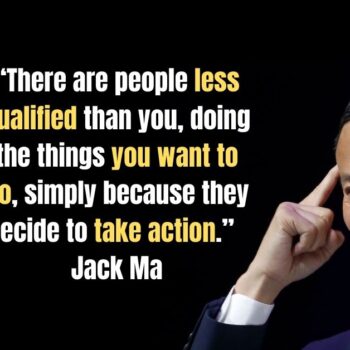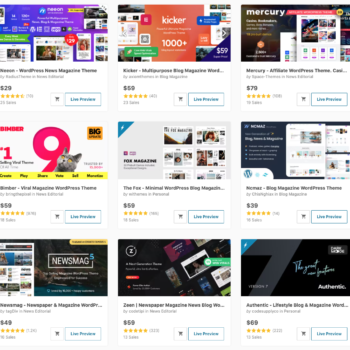Choosing the right blogging platform is like picking your adventure vehicle. Do you want a simple scooter to get around town or a powerful off-roader built for limitless exploration? With so many options out there, it’s easy to feel lost at the starting line.
While there are other good platforms, WordPress stands apart as the most popular and powerful choice for bloggers of all levels. Think of it as that off-roader – it can take you anywhere you want to go in the blogging world.
Don’t worry if terms like “self-hosted” and “hosted” sound confusing right now. We’ll break that down shortly. For now, know this: WordPress gives you unparalleled control, endless customization options, and the tools to turn your blog into a serious online business.
Ready to unlock your blogging potential? Let’s dive into why WordPress might be your perfect ride.
Profitable Blog Niches: Where Passion Meets Profit
Choosing the right niche is the foundation of a successful blog. It’s where your passion and expertise intersect with audience demand, creating a fertile ground for growth and monetization. But with so many options, how do you find your perfect fit?
The Power of Passion:
Blogging is a marathon, not a sprint. To sustain your motivation and creativity, choose a niche you’re genuinely passionate about. What topics excite you? What knowledge are you eager to share? Your enthusiasm will shine through in your writing, drawing readers in and keeping them engaged.
Don’t underestimate the power of authenticity. Your readers can sense when you’re truly passionate about a subject, and it makes your content more relatable and trustworthy. Plus, when you’re writing about something you love, it doesn’t feel like work. It’s a joy, an outlet for your creativity, and a way to connect with like-minded individuals.
The Profit Potential:
While passion is essential, it’s also important to consider the profit potential of your chosen niche. Some niches are naturally more lucrative than others due to higher advertising rates, affiliate marketing opportunities, or the potential for creating and selling digital products. However, even less commercial niches can be monetized through sponsorships, brand partnerships, or by offering consulting services.
Here are some key factors to consider when assessing a niche’s profit potential:
- Audience size: A larger audience means more potential customers or clients.
- Demand for products or services: Are there products or services related to your niche that people are actively searching for and willing to pay for?
- Advertising rates: Some niches have higher advertising rates than others, meaning you can earn more per click or impression.
- Affiliate marketing opportunities: Are there affiliate programs in your niche that offer attractive commissions?
Finding Your Sweet Spot:
The ideal niche is one where your passion and expertise align with a profitable market. Don’t be afraid to niche down and focus on a specific subtopic within a broader category. For example, instead of a general fitness blog, you could focus on yoga for beginners, plant-based nutrition, or running for weight loss. This allows you to target a specific audience and become a go-to resource in your chosen area.
Remember, choosing a niche isn’t a one-time decision. You can always pivot or expand your focus as your blog grows and evolves. The most important thing is to start with a solid foundation and build from there.
Exploring Profitable Niches:
To get you started, here are some profitable blog niches with examples:
- Fitness: Workout routines, nutrition advice, product reviews, motivational stories.
- Beauty: Makeup tutorials, skincare routines, product reviews, beauty trends.
- Technology: Gadget reviews, software tutorials, industry news, how-to guides.
- Finance: Budgeting tips, investing advice, financial news, product reviews.
- Travel: Destination guides, travel tips, itineraries, cultural insights.
- Food: Recipes, cooking tips, restaurant reviews, culinary adventures.
- Lifestyle: Fashion, beauty, home decor, parenting, personal development.
- Business/Entrepreneurship: Case studies, interviews with entrepreneurs, business tips.
- Personal Development: Self-improvement tips, motivational stories, goal-setting advice.
In the next section, we’ll delve into the different types of blog topics within these niches and explore the pros and cons of evergreen and trending content.
Evergreen vs. Trending Blog Topics: The Balancing Act for Long-Term Success
Now that you’ve explored the world of profitable niches, it’s time to delve into the types of content you can create within those niches. In the blogging sphere, content can be broadly categorized into two types: evergreen and trending. Each has its own strengths and weaknesses, and understanding their differences is key to crafting a balanced and effective content strategy.
Evergreen Content: The Timeless Foundation
Evergreen content refers to topics that remain relevant and valuable to readers over an extended period. These topics tackle fundamental questions, problems, or interests that aren’t tied to specific events or trends. Think of them as the bedrock of your blog, providing a consistent source of traffic and establishing your authority in your niche.
Examples of Evergreen Topics:
- How-to guides and tutorials (e.g., “How to Start a Blog,” “The Ultimate Guide to SEO”)
- Ultimate guides and in-depth resources (e.g., “The Complete Guide to Investing for Beginners,” “The Ultimate Travel Packing List”)
- Product reviews and comparisons (e.g., “Best Laptops for Students,” “Top 10 Cameras for Travel Photography”)
- Historical events or figures (e.g., “The Life of Albert Einstein,” “The History of the Civil Rights Movement”)
Benefits of Evergreen Content:
- Long-term traffic: Evergreen content continues to attract organic search traffic long after it’s published.
- Authority building: In-depth, informative evergreen content establishes you as an expert in your field.
- Link attraction: Quality evergreen content is more likely to earn backlinks from other websites, further boosting your SEO.
- Repurposing potential: Evergreen content can be easily repurposed into different formats (e.g., videos, social media posts, infographics).
Trending Content: Riding the Wave of Popularity
Trending content, on the other hand, focuses on timely topics that are currently popular or generating buzz. This could include news stories, current events, seasonal topics, or viral trends. While trending content can drive a surge of traffic in the short term, its relevance often fades as new trends emerge.
Examples of Trending Topics:
- News articles and opinion pieces (e.g., “The Latest Developments in AI Technology,” “What the New Tax Laws Mean for You”)
- Seasonal content (e.g., “Holiday Gift Guides,” “Summer Fashion Trends”)
- Viral challenges or trends (e.g., “The Ice Bucket Challenge,” “The Mannequin Challenge”)
- Celebrity news or gossip (e.g., “The Met Gala’s Most Daring Looks,” “The Latest Celebrity Breakup”)
Benefits of Trending Content:
- Short-term traffic boost: Trending topics can attract a significant amount of traffic in a short period.
- Increased social media engagement: Trending topics are often highly shareable on social media, leading to more visibility.
- Newsjacking opportunities: By covering trending topics, you can position yourself as a source of timely information.
The Right Balance: Combining Evergreen and Trending Content
While both evergreen and trending content have their merits, the key is to find the right balance for your blog. A healthy mix of both ensures you provide lasting value while also capitalizing on current interests.
- Evergreen content: Focus on building a solid foundation of evergreen content that attracts consistent traffic and establishes your expertise.
- Trending content: Sprinkle in trending topics to capitalize on current interests and attract new readers.
- Repurpose content: Repurpose evergreen content into different formats to keep it fresh and relevant.
- Monitor trends: Stay up-to-date on the latest trends in your niche and create content that aligns with them when appropriate.
By strategically combining evergreen and trending content, you can create a dynamic and engaging blog that attracts a diverse audience and maintains long-term success.
Finding Blog Topic Ideas: Where Creativity Meets Strategy
Now that you have a solid understanding of profitable niches and the types of content you can create, it’s time to embark on the exciting quest for blog topic ideas. This is where your creativity and strategic thinking come together to uncover a treasure trove of possibilities.
Brainstorming Techniques to Ignite Your Imagination:
- Mind Mapping: Start with a central theme (your chosen niche) and let your mind wander, branching out with related topics, subtopics, and keywords. This visual representation of interconnected ideas can help you uncover unexpected connections and spark new possibilities.
- Keyword Research: Use keyword research tools like Google Keyword Planner, Ahrefs, or Semrush to identify popular search terms related to your niche. These keywords represent what your target audience is actively searching for, giving you valuable insights into their interests and pain points. Look for both short-tail (broader) and long-tail (more specific) keywords to create a diverse range of content.
- Competitor Analysis: Take a peek at what other successful blogs in your niche are writing about. This can provide valuable inspiration and reveal content gaps you can fill. Remember, the goal isn’t to copy their ideas, but rather to use them as a springboard for your own unique and creative content.
Online Tools for Endless Inspiration:
- Google Trends: This handy tool unveils trending search terms and topics, giving you a real-time pulse on what’s capturing people’s attention. You can filter by region, time period, and category to find relevant trends in your niche.
- BuzzSumo: Dive into the most shared content on social media for any given topic or keyword. BuzzSumo helps you identify trending topics and content formats that resonate with your target audience, giving you a competitive edge.
- Answer the Public: This ingenious tool generates a list of questions people are asking online related to your keyword. These questions can serve as excellent blog post ideas, ensuring you’re creating content that directly addresses your audience’s needs and interests.
Tap into Your Audience’s Wisdom:
Your audience is a goldmine of blog topic ideas! Engage with them through:
- Social Media Polls: Ask your followers what they want to learn more about or what challenges they’re facing. This direct feedback can guide your content creation and ensure you’re addressing their most pressing concerns.
- Q&A Sessions: Host Q&A sessions on social media or your blog to answer questions and spark new ideas for future content. This interactive approach can deepen your connection with your audience and foster a sense of community.
- Blog Comments: Pay attention to the comments on your blog posts. What questions are your readers asking? What topics are they discussing? This valuable feedback can guide your content creation and ensure you’re meeting your audience’s needs.
Remember, finding blog topic ideas is an ongoing process. Stay curious, explore your niche, and don’t be afraid to experiment with different formats and topics. The more you create, the more ideas will flow naturally. In the next section, we’ll share a treasure trove of popular blog topic ideas across various niches to spark your creativity and get you started on your content creation journey.
Popular Blog Topic Ideas (with Examples)
Now that we’ve explored niches and content types, let’s dive into a treasure trove of popular blog topic ideas across various niches to spark your creativity. Remember, these are just a starting point – feel free to adapt, combine, and personalize them to fit your unique voice and audience:
Travel:
- Share Your Bucket List: Inspire wanderlust by revealing your dream destinations and travel goals.
- Write About Your Recent Travel Experiences: Share detailed itineraries, travel tips, and hidden gems from your adventures.
- Destination Guides: Offer comprehensive guides to popular destinations, covering everything from must-see attractions to local cuisine and cultural experiences.
- Travel Tips and Hacks: Share budget travel tips, packing hacks, or tips for traveling with kids or pets.
- Travel Photography: Showcase your travel photography skills and offer tips for capturing stunning images on the go.
- Travel Gear Reviews: Review luggage, backpacks, travel gadgets, and other essentials for globetrotters.
- Cultural Insights: Delve into the cultural nuances of different destinations, offering insights into local customs, traditions, and etiquette.
Food:
- Recipes for Couples Without Children: Share quick and easy recipes, date night dinners, and entertaining ideas for couples.
- Restaurant Reviews: Review local restaurants, cafes, and food trucks, offering recommendations for different cuisines and occasions.
- Cooking Tips and Techniques: Share tips on basic cooking skills, kitchen organization, and meal prepping.
- Healthy Eating: Offer nutritious recipes, meal plans, and tips for maintaining a healthy lifestyle.
- Baking and Desserts: Share delicious baking recipes, dessert ideas, and tips for decorating cakes and cookies.
- Foodie Travel: Combine your love for food and travel by sharing culinary experiences from around the world.
- Food Photography: Showcase your food photography skills and offer tips for taking mouthwatering pictures.
Lifestyle:
- Organize Your Thoughts: Share productivity hacks, tips for decluttering, and strategies for managing stress.
- Productivity and Time Management Hacks: Offer tips on time management, goal setting, and achieving work-life balance.
- Personal Development Tips: Share insights on self-improvement, personal growth, and overcoming challenges.
- Home Decor and DIY Projects: Inspire readers with home decor ideas, DIY tutorials, and tips for creating a cozy and inviting space.
- Fashion and Style: Share fashion tips, outfit ideas, and reviews of clothing and accessories.
- Parenting Advice: Offer tips for raising children, navigating parenthood challenges, and creating a loving and supportive family environment.
- Relationships and Dating: Share advice on building healthy relationships, dating tips, and communication strategies.
Business/Entrepreneurship:
- Case Studies: Share success stories of entrepreneurs and businesses, highlighting their strategies and lessons learned.
- Interviews with Successful Entrepreneurs: Interview inspiring business leaders and share their insights and advice.
- Business Tips and Strategies: Offer practical tips on starting and growing a business, marketing, sales, and leadership.
- Freelancing and Consulting: Share tips for freelancers and consultants on finding clients, setting rates, and managing projects.
- E-commerce: Offer advice on starting and running an online store, product sourcing, and marketing strategies.
- Marketing and Branding: Share tips on branding, social media marketing, content marketing, and email marketing.
- Business Finance: Provide insights on financial management, accounting, and funding options for businesses.
Personal Development:
- Self-Improvement Tips: Share actionable advice on setting goals, overcoming obstacles, and building confidence.
- Motivational Stories: Inspire readers with stories of personal growth, resilience, and overcoming adversity.
- Mindfulness and Stress Reduction Techniques: Offer tips on meditation, yoga, and other practices for reducing stress and promoting well-being.
- Goal Setting and Achievement: Share strategies for setting and achieving goals, both personal and professional.
- Habits and Productivity: Offer tips on building positive habits, improving productivity, and maximizing time management.
- Relationships and Communication: Share advice on building healthy relationships, improving communication skills, and resolving conflicts.
- Mental Health and Well-being: Discuss topics related to mental health, such as anxiety, depression, and self-care.
Fitness:
- Workout Routines:
- Beginner-friendly workouts for those just starting their fitness journey.
- Advanced routines for seasoned fitness enthusiasts looking for a challenge.
- At-home workouts for those who prefer to exercise in the comfort of their own home.
- Workout routines for specific goals (e.g., weight loss, muscle gain, endurance).
- Exercise modifications for injuries or limitations to ensure safe and effective workouts.
- Nutrition Advice:
- Meal plans for different goals (e.g., weight loss, muscle gain, vegetarian/vegan).
- Healthy recipes: Quick and easy meals, snacks, post-workout meals, desserts.
- Nutrition tips: Advice on macronutrients, micronutrients, supplements, and healthy eating habits.
- Debunking nutrition myths: Addressing common misconceptions about food and nutrition.
- Fitness Gear Reviews:
- Honest reviews of workout clothes, shoes, equipment, and wearable technology.
- Comparison guides to help readers choose the best products for their needs and budget.
- Recommendations for specific activities (e.g., running shoes, yoga mats, gym bags).
- Motivational Stories:
- Personal stories of overcoming fitness challenges and achieving goals.
- Interviews with fitness experts, athletes, and trainers.
- Inspirational stories from the fitness community.
- Productivity and Time Management Hacks:
- Tips for optimizing your workouts and fitting exercise into a busy schedule.
- Strategies for balancing fitness with work, family, and other commitments.
- Productivity hacks for achieving fitness goals faster.
Beauty:
- Makeup Tutorials:
- Step-by-step guides for beginners, covering basic techniques and everyday looks.
- Advanced tutorials for makeup enthusiasts, featuring creative and complex looks.
- Tutorials for specific occasions (e.g., weddings, parties, holidays).
- Video tutorials demonstrating makeup application techniques.
- Skincare Routines:
- Routines for different skin types (e.g., oily, dry, combination, sensitive).
- Product recommendations for various skin concerns (e.g., acne, aging, hyperpigmentation).
- DIY skincare tips using natural ingredients.
- Reviews of skincare products, including both high-end and affordable options.
- Hair Care Tips:
- Styling tutorials for different hair types and lengths.
- Hair care product reviews, highlighting the best shampoos, conditioners, and styling products.
- Natural hair care tips for those who prefer to avoid harsh chemicals.
- Advice on dealing with common hair problems (e.g., frizz, dandruff, hair loss).
- Beauty Product Reviews:
- Honest reviews of makeup, skincare, and haircare products.
- Comparison guides to help readers choose the best products for their needs and budget.
- “Holy Grail” product recommendations based on personal experience and research.
- Beauty Trends:
- Latest trends in makeup, hairstyles, nail art, and skincare.
- Runway-inspired looks and how to recreate them.
- Celebrity beauty secrets and how to get the look of your favorite stars.
- Beauty on a budget: Affordable makeup and skincare options.
Technology:
- Product Reviews:
- In-depth reviews of the latest smartphones, laptops, tablets, and other gadgets.
- Comparison guides to help readers choose the best tech products for their needs and budget.
- “Best of” lists highlighting the top-rated products in different categories (e.g., best wireless earbuds, best smartwatches).
- Honest feedback on new software releases and app updates.
- How-To Guides:
- Step-by-step tutorials on using specific software, apps, or devices.
- Guides on troubleshooting common tech problems.
- Tips for maximizing productivity and efficiency with technology.
- DIY tech projects for tech enthusiasts and hobbyists.
- Tech Industry News and Analysis:
- Coverage of the latest developments in the tech industry, including new product launches, mergers and acquisitions, and emerging trends.
- Analysis of market trends and predictions for the future of technology.
- Opinion pieces on controversial tech topics and ethical considerations.
- Tech Comparisons:
- Head-to-head comparisons of competing products (e.g., iPhone vs. Android, MacBook vs. Surface Laptop).
- Pros and cons of different technologies (e.g., cloud storage vs. local storage, wired vs. wireless headphones).
- Guides to help readers choose the best technology for their specific needs and budget.
- Emerging Technologies:
- Exploration of cutting-edge technologies like artificial intelligence, virtual reality, and blockchain.
- Potential impact of emerging technologies on society and various industries.
- Ethical considerations surrounding the development and use of new technologies.
- Tech Events Coverage:
- Live coverage of major tech conferences and events (e.g., CES, Apple WWDC, Google I/O).
- Summaries and analysis of key announcements and product launches.
- Interviews with tech experts and industry leaders.
Finance:
- Personal Finance Tips:
- Budgeting tips for different income levels and lifestyles.
- Saving strategies for achieving financial goals (e.g., buying a house, retirement).
- Debt management advice, including strategies for paying off credit card debt and student loans.
- Tips for managing finances as a couple or family.
- Investment Strategies:
- Beginner’s guides to investing in the stock market, real estate, and other assets.
- Advanced investment strategies for experienced investors.
- Analysis of different investment options and their potential risks and rewards.
- Retirement planning tips, including strategies for maximizing retirement income.
- Financial News and Analysis:
- Market updates and analysis of economic trends.
- Financial advice for different life stages (e.g., young adults, families, retirees).
- Explanations of complex financial concepts in simple terms.
- Opinion pieces on current financial issues and debates.
- Financial Product Reviews:
- Reviews of credit cards, bank accounts, investment platforms, and other financial products.
- Comparison guides to help readers choose the best financial products for their needs and budget.
- Tips for avoiding scams and protecting your finances.
- Taxes and Personal Finance:
- Tax tips for individuals and businesses.
- Deductions and credits you may be eligible for.
- Tax planning strategies to minimize your tax liability.
- How to prepare your taxes and file your return.
This is just a small sample of the vast array of blog topic ideas available in the fitness and beauty niches. By exploring these topics and finding your own unique angle, you can create engaging and informative content that resonates with your audience and sets your blog apart.
Remember, this list is just a starting point. As you explore your niche and connect with your audience, you’ll discover countless other engaging and profitable blog topics to share. Don’t be afraid to experiment, try new formats, and listen to your readers’ feedback. The key is to consistently create high-quality content that provides value and resonates with your audience.
How to Choose the Right Blog Topic: Your Blueprint for Success
Now that you’ve got a treasure trove of potential blog topic ideas, how do you actually choose the right ones? It’s not just about picking what sounds interesting—it’s about finding those topics that will truly resonate with your audience and help you achieve your blogging goals.
Understanding Your Audience:
The first step to choosing the right blog topics is understanding your target audience. Who are they? What are their interests, needs, and pain points? What kind of content are they looking for?
You can gather this information through various methods, such as:
- Surveys and polls: Ask your audience directly what they want to see more of on your blog.
- Social media analytics: Analyze your social media followers’ demographics and interests.
- Keyword research: Use keyword research tools to identify what topics people are searching for.
- Competitor analysis: See what topics are popular among other blogs in your niche.
Once you have a good understanding of your audience, you can start to tailor your blog topics to their specific needs and interests. This will help you create content that is both valuable and engaging, which is essential for building a loyal following.
Aligning with Your Goals:
Your blog topics should also align with your overall blogging goals. What do you want to achieve with your blog? Are you trying to build an email list, drive traffic to a product or service, or establish yourself as an expert in your field?
Once you know your goals, you can choose topics that will help you achieve them. For example, if you want to build an email list, you could write blog posts that offer a free download in exchange for an email address. If you want to drive traffic to a product or service, you could write blog posts that review or compare different products or services.
Finding the Sweet Spot:
The ideal blog topic is one that sits at the intersection of your audience’s interests, your expertise, and your blogging goals. It’s a topic that you’re passionate about, that your audience wants to read about, and that will help you achieve your goals.
When choosing blog topics, don’t be afraid to experiment. Try out different topics and see what resonates with your audience. The more you write, the better you’ll get at understanding what your readers want.
Additional Tips for Choosing Blog Topics:
- Don’t be afraid to niche down: The more specific your niche, the easier it will be to stand out from the crowd.
- Write evergreen content: Evergreen content is content that is always relevant, regardless of the time of year or current trends. This type of content will continue to attract traffic to your blog long after it’s been published.
- Update your old content: Keep your blog fresh by updating your old content with new information or perspectives.
- Promote your blog posts: Share your blog posts on social media, email newsletters, and other channels to get them seen by a wider audience.
By following these tips, you can choose blog topics that will help you achieve your blogging goals and build a successful blog.
Tips for Creating Engaging Blog Content That Captivates and Converts
Congratulations! You’ve made it through the strategic planning phase and have a list of killer blog topics that are sure to resonate with your audience. Now comes the fun part: creating content that not only informs but also entertains, captivates, and ultimately, converts readers into loyal followers.
- Craft Compelling Headlines: Think of your headline as a movie trailer – it needs to entice viewers (readers) to click and consume your content. A compelling headline should be concise, relevant to your topic, and pique curiosity. It should also include your target keyword, but don’t sacrifice creativity for SEO. Some effective strategies include using numbers (e.g., “7 Proven Ways…”), posing a question, or promising a solution to a common problem.
- Weave Visual Delights into Your Narrative:
Humans are visual creatures, and incorporating visuals into your blog posts can make them more engaging and memorable. Don’t just rely on stock photos; create custom graphics, infographics, and videos to illustrate your points and add personality to your blog.
- Format for Readability:
No one enjoys reading a giant wall of text. Break your content into smaller paragraphs, use subheadings to organize your thoughts, and incorporate bullet points or numbered lists for easy scanning. Opt for a clear, concise writing style, avoiding jargon and overly complex sentences.
- Tell Stories That Resonate:
Stories are powerful tools for connecting with your audience on a deeper level. Share personal anecdotes, case studies, or real-life examples that illustrate your points and make your content more relatable. Storytelling can evoke emotions, inspire action, and leave a lasting impression on your readers.
- Amplify Your Reach Through Social Media:
Your blog doesn’t exist in a vacuum. Share your posts on social media platforms like Twitter, Facebook, Instagram, Pinterest, and LinkedIn. Tailor your posts to each platform’s unique style and audience. Engage with your followers, respond to comments, and join relevant groups or communities to expand your reach and attract new readers.
- Cultivate a Thriving Community:
Blogging is a two-way street. Don’t just broadcast your message – actively engage with your audience. Respond to comments on your blog posts, answer questions, and participate in discussions. This shows your readers that you value their feedback and fosters a sense of community around your blog. Consider hosting Q&A sessions or live chats to further interact with your audience and gather valuable insights.
- Optimize for Search Engines:
While creating engaging content is paramount, don’t neglect the power of search engine optimization (SEO). Research relevant keywords for your topics and incorporate them naturally into your titles, meta descriptions, headers, and content. This will help your blog posts rank higher in search results, attracting more organic traffic and increasing your visibility.
By implementing these tips, you can create blog content that not only informs and entertains but also builds a loyal following and drives meaningful results. Remember, successful blogging is a marathon, not a sprint. Be consistent, deliver value, and stay true to your voice. Your blog has the power to make a difference, one post at a time.
Conclusion: Your Roadmap to Blogging Success
Choosing the right blog topics is a journey of self-discovery, audience understanding, and strategic planning. It’s about finding the sweet spot where your passion, expertise, and audience demand intersect. This sweet spot is where your blog will truly thrive, attracting readers who resonate with your message and are eager to engage with your content.
Throughout this guide, we’ve explored profitable niches, the balance between evergreen and trending content, and brainstorming techniques to uncover a wealth of ideas. But most importantly, we’ve highlighted the critical crossroads you face as a blogger: the choice between a strategic, planned approach to topic selection and a haphazard, directionless path. The decision you make here will significantly impact your blog’s success, influencing your traffic, earnings, and overall growth.
Remember, there’s no one-size-fits-all answer to the question of what to blog about. The best topics are those that you’re genuinely excited about and that resonate with your target audience. By carefully considering your interests, expertise, audience demand, and monetization potential, you can create a blog that not only fulfills your creative aspirations but also achieves your long-term goals.
If you’re feeling overwhelmed, don’t worry. Start small and experiment with different topics. Listen to your audience’s feedback and be willing to pivot or refine your focus as you learn and grow. The most important thing is to be consistent, create high-quality content, and never stop learning.
The blogging world is vast and full of possibilities. By choosing the right path and following the strategies outlined in this guide, you can unlock your blog’s full potential and embark on a fulfilling and successful blogging journey. So, what are you waiting for? Start brainstorming, experimenting, and creating content that truly speaks to your readers. Your blog has the power to make a difference, one post at a time.
Happy blogging!









No Comments
Leave a comment Cancel